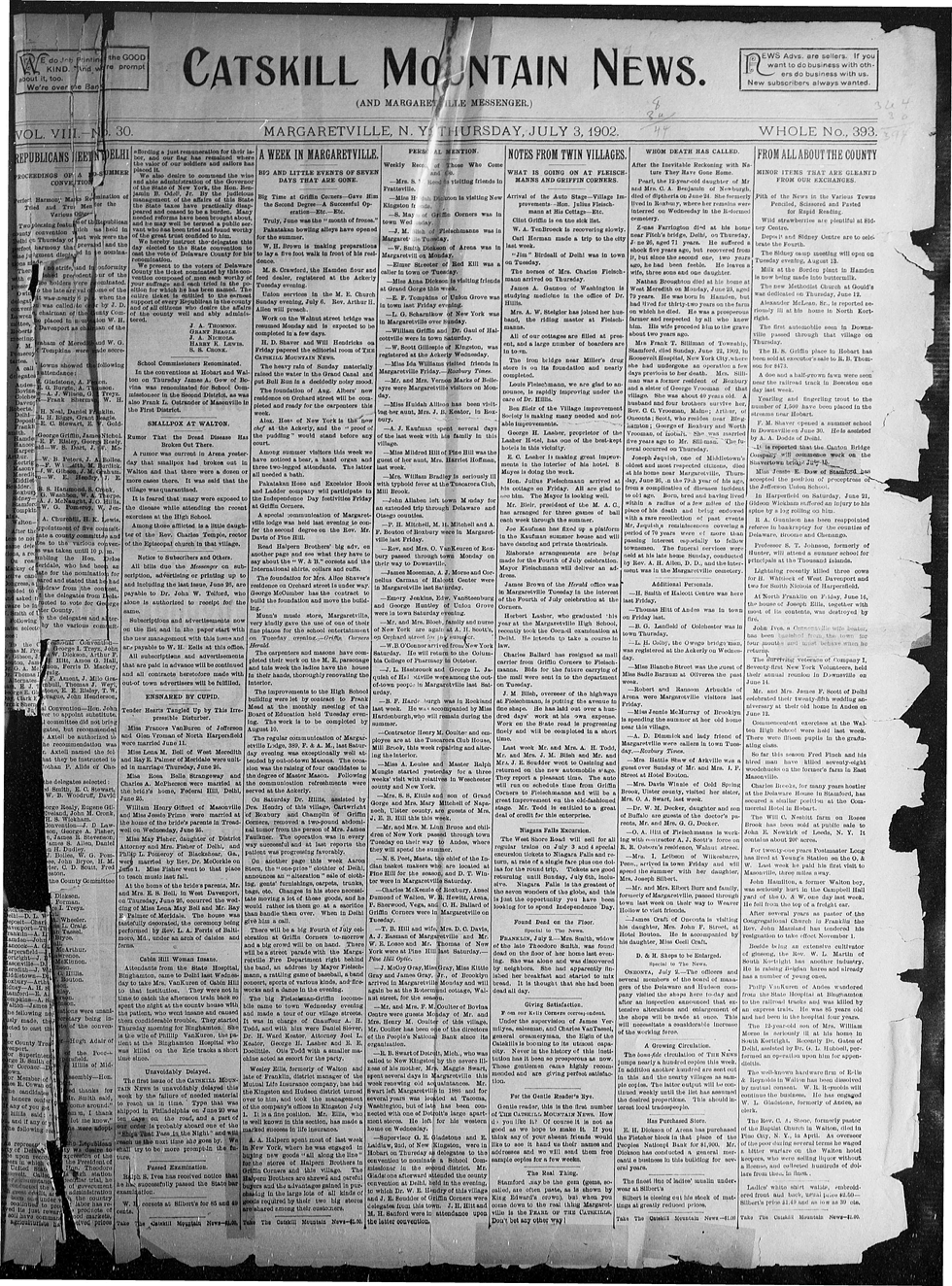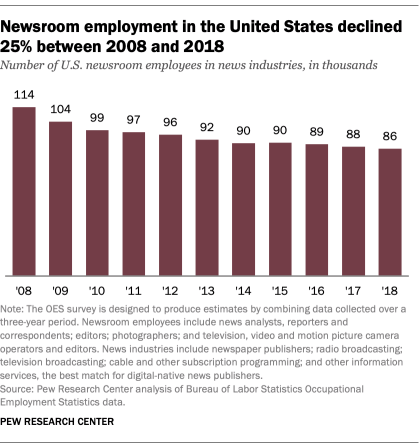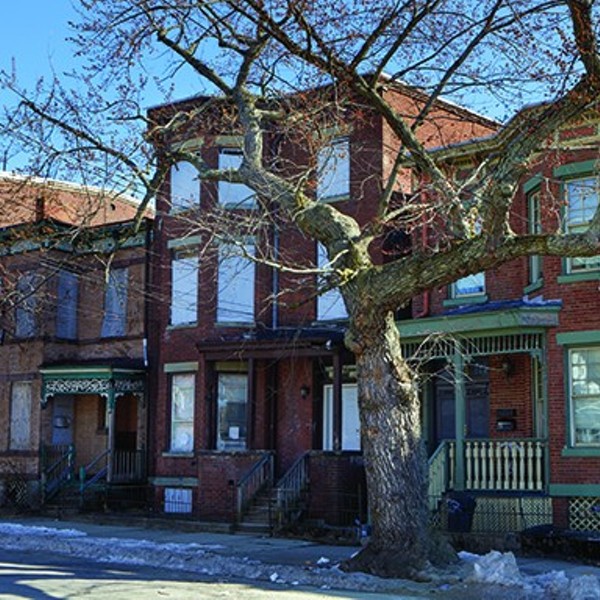“All happy families are alike; each unhappy family is unhappy in its own way.”
—Leo Tolstoy, Anna Karenina
In the past decade and a half, some 2,100 American newspapers have winked out of existence, driven into the ground by plummeting ad revenues, declining subscriptions, media consolidation, publisher exhaustion, or all of the above. According to a 2018 report by Penny Abernathy, a University of North Carolina researcher chronicling the desertification of the American news landscape, nearly one out of every five newspapers has been lost.
On January 22, the Catskill Mountain News, a tiny print weekly based in the Delaware County village of Margaretville, added to the numbers.
“A series of technical, staffing, and financial issues that include the electronic hijacking of our e-mails and archives as well as plagiarism of our work has forced us to step back and revisit what we are doing and how we are doing it,” publisher Joan Lawrence-Bauer wrote in a somewhat cryptic Facebook post alerting the community to the shutdown, and hinting that the paper might be reborn in some fashion. “We hope to be back on the newsstands and in your mailboxes, but are uncertain at this time when or if that can happen.”
The Catskill Mountain News shut down with Lawrence-Bauer still in debt to longtime owner Dick Sanford, grandson of the newspaper’s founder. Another nearby paper, the Schoharie-based Mountain Eagle, has moved into some of the Catskill Mountain News’s territory over the past year, and has replaced the Margaretville paper as the official carrier of legal notices for several local governments—possibly under the guidance of Brian Sweeney, an embittered former Catskill Mountain News staffer who was fired by Lawrence-Bauer in 2018 and now works at the Eagle. All three declined to speak to me on the record, and a report by another former Catskill Mountain News staffer in the Woodstock Times suggests that legal action may be forthcoming.
It was an ignominious end to 116 years of continuous publication. The late Catskill Mountain News leaves in its wake a mess of broken business and personal relationships, a worrying uncertainty about the future of local news, and a community now even more deeply impoverished for homegrown media. It’s a story that is unfolding in similar ways in towns and cities across the nation, as news outlets continue to shrink and close—but each story is different, and each one worth telling.
If it is true that local matters, then it must also be true that the problems of local news are not the same everywhere. Every news ecosystem is unique, and solutions may also need to be tailored uniquely, if they are to work in different kinds of communities.
The rural Catskills, where the Catskill Mountain News occupied an important niche as the oldest and most august of the local papers, is plagued with many of the same problems facing local news everywhere. Local businesses are spending more of their limited marketing dollars on Facebook and Google instead of local media outlets. Readers are becoming more reliant on social media for news and other information, a dynamic that puts news outlets in competition with Facebook for reader attention even as it makes publishers more dependent on the platform to deliver an audience. Growing public distrust of news reporting, fanned by anti-press rhetoric at the highest levels of government, has made it easier for elected officials to denounce local media and stonewall public access to information. The shuttering and consolidation of printing presses are leaving small publishers with fewer and more logistically challenging options.
But the region also has its own homegrown troubles. The widespread economic and cultural problems that bedevil the rural Catskills region both complicate and exacerbate the challenges facing our local news ecosystem.
Like climate change, or ecological collapse, the death spiral of local news is a crisis with many feedback loops, in which the failure of one part of the system accelerates damage to the rest. Community fragility—which, in the rural Catskills, takes the form of widespread economic hardship, population decline, and the hollowing out of civic life—makes a local news ecosystem especially vulnerable to irreversible disruption. And like a natural ecosystem, once local news is lost, it will be much harder to rebuild than it would be to preserve it from the beginning.
A Fractured Landscape
The Catskills region is indisputably a news desert. Coverage of local government is thin, and mostly appears in tiny outlets with low circulation. Public meetings in dozens of small towns and villages often go uncovered by any reporter. The region’s sparse population and physical inaccessibility act as barriers to the flow of information, both in news media and in the community at large.
Somewhat paradoxically, regional businesses that serve an upscale clientele often command a wide media reach that far exceeds their economic impact. The Catskills’ natural beauty and idiosyncratic culture are alluring to would-be entrepreneurs, not to mention metropolitan reporters who cover food, lifestyle, arts, and culture. With a little savvy self-promotion, an entrepreneur with existing media connections outside the region can rely on the robust media ecosystem of New York City to generate coverage, lending an air of prestige to a new business. Far from helping to nourish the relationship between the news media and the local economy, this dynamic only exacerbates the problem: Local press is not terribly important to businesses whose tourist and weekender clientele does not read local newspapers, and organizations with enough cultural power to bypass the local press entirely often do not support local news with advertising.
The daily newspapers that surround the region—the Daily Freeman in Kingston, the Daily Mail in Catskill, the Daily Star in Oneonta, the Times Herald-Record in Middletown—are much more focused on their core territory than their rural outskirts, and have all undergone sharp cutbacks in editorial staffing in recent years. Broadcast news in the region is all but nonexistent.
The print weeklies that do the lion’s share of local news coverage in Catskills rural towns are intensely vulnerable. Many have gone out of business in the past decade or so: the Windham Journal, the Phoenicia Times, the Olive Press, the Ulster County Townsman, the Towne Crier, the Tri-Town News, the Delaware County Times. Of the ones that remain, some have publishers approaching retirement with no clear succession plan, or are run by people with little news experience. A few have changed ownership for less than the price of a used car, or even a cup of coffee.
Digital-only news is almost nonexistent in the region, an unfilled niche that gives me a pang to contemplate. From 2010 to 2017, I ran the Watershed Post, a digital news outlet dedicated to the rural Catskills, with my wife, Julia Reischel. When we made the decision to shut down, we had a devoted and growing readership, but the revenue we were able to bring in was never robust enough to match the ambition of our mission or to pay ourselves a salary commensurate to the work.
The Talent Pool Is Drying Up
I spoke recently with Tim Knight, a young local reporter who currently freelances for the Mountain Eagle. You’d be hard-pressed to find another twentysomething in the region with more demonstrated commitment to local news: In 2013, while still an undergrad at SUNY Cobleskill, he launched the Schoharie News, a digital-news outlet that has since merged with the Mountain Eagle and come under new ownership. He’s been involved in every aspect of the local news business, from writing the stories to selling the ads to crisscrossing county lines with a car full of papers to deliver.
Knight says he doesn’t see a future for himself in local news.
“I see the writing on the wall, and it’s not very favorable to local news,” he says. “I’m in the process of finishing up my master’s in political communication, and I don’t want to waste that degree.”
The economy of the rural Catskills is weak. Locals often bemoan the lack of good jobs in the region, but that’s only half of the story. Small businesses in the rural Catskills struggle to fill skilled positions; the lack of qualified workers is a common lament of business owners.
For the news media, the problem is acute. Finding reporters to cover local government often means training them. A little over an hour southeast of Margaretville, SUNY New Paltz runs a well-regarded journalism school, but it might as well be on the moon; J-school grads do not head for the rural Catskills once they finish their degrees, and there is little incentive for them to do so.
The problem is made worse by increasing pressure on revenues and shrinking mastheads. Editors have little time to mentor aspiring reporters, and the local news world offers few opportunities for advancement. Full-time jobs for local news reporters are vanishingly scarce, and freelance pay hovers in the realm of $40-50 a story, a rate well below minimum wage. There is little incentive for either news outlets or local writers to develop the skills and expertise needed to do quality local journalism.
Although it gets less attention (and probably less public sympathy), the dearth of sales talent is a problem on par with reporter scarcity in the region. Most local papers rely heavily on the efforts of a handful of salespeople who have been in the industry for decades and have longstanding relationships with advertisers. Without an inherited legacy of close business relationships, local papers would be struggling even more.
As the local media ecosystem thins out, the talent pool is becoming shallower. The region is rapidly losing a culture that cultivates reporting expertise and understands journalistic ethics. As for fluency with the emerging tools of digital publishing, most local news outlets don't have these skills, and are thus ill-equipped to train aspiring journalists in them. With few experienced local reporters on the ground, even a well-funded local news startup would be hard pressed to assemble a team without investing heavily in training.
One local bright spot in this arena is Manor Ink, a community newspaper in Livingston Manor run by local high school students, and sponsored by the local library. The project is funded through a mix of community donations and foundation funding, and relies on a generous amount of volunteer labor to keep it running.
A Culture Divided
Within any community, there are cultural divisions that impact news coverage and access to locally relevant journalism. Language barriers are a hurdle that news organizations both large and small often fail to overcome; this is true in the Catskills as well, where various immigrant communities get scant attention from local news media, despite their obvious size and importance to local economy and culture.
But in the Catskills, the most obvious cultural divide the news struggles to bridge is one steeped in tension around class, prestige, and perceived urbanity. The divide between “locals” and “transplants” is apparent in many aspects of local life, but perhaps nowhere more so than in the production and consumption of local media.
In the past decade, as local news media has shrunk in the Catskills, another kind of publication has become more ubiquitous: the prestige lifestyle publication. The resurgence of the Catskills as a destination for creative types has brought with it the launch of DVEIGHT, And North, Upstate Diary, and other publications that explicitly cater to an audience “from away.” Heavy on whitespace, focused on the lives and businesses of transplants, and sometimes physically distributed in New York City neighborhoods to catch the attention of would-be upstaters, the prestige media of the Catskills paints a portrait of a world apart.
Not all of the new lifestyle publications accept advertising. Some charge steep fees for high-end events, like And North’s “Soirée on the Railway”—a lavish dinner party on a train that rolls past flood-damaged homes and a local trailer park. Some produce advertorial content that, to readers, is indistinguishable from editorially driven stories—a practice that would be verboten at a news outlet with a functioning sense of journalistic ethics, and which helps contribute to a local culture in which businesses routinely demand positive coverage in exchange for advertising.
It is unclear whether most of these outlets have a business model any more functional than that of a struggling local newspaper; some are clearly an expensive labor of love. But what does seem clear is that they have captured the attention—and a chunk of the local marketing dollars—of the businesses they cover, and are creating a separate media/business ecosystem that is almost entirely divorced from the grubby business of local life and government.
Rural prestige media did not cause the uncoupling of creative transplant culture from rural civic life, and even if the advertising budgets these outlets have captured were poured into local newspapers, it would probably not be sufficient to stem the bleeding. But the rise of the heavily curated rural lifestyle magazine, and its embrace by businesses that rely on aesthetic appeal, is a symptom of a larger issue: Local news has a branding problem. The prestige hierarchy within journalism itself, in which ambitious and talented young people are systematically funneled toward larger, more nationally oriented outlets, isn’t helping.
Solutions on the Table
In recent years, some large-scale efforts to invest in strengthening local news have emerged. The Knight Foundation has shifted much of its energy from funding “innovation” to supporting local news media. In 2019, the foundation announced a five-year, $300 million commitment to funding local news, much of which will support local nonprofit news outlets. Few such outlets exist in or near the rural Catskills, but perhaps projects like this could provide seed funding for their creation.
Report for America, a foundation-supported initiative that funds and places reporters in local newsrooms across the country, has expanded dramatically this year, and will fund 250 one- to two-year newsroom jobs. ProPublica’s Local Reporting Network offers year-long fellowships to experienced reporters who partner with sponsoring local news outlets on deep investigative stories.
As newsrooms shrink, some researchers are promoting collaboration between outlets as a possible aid to doing more ambitious coverage. One such effort is Project Facet, helmed by reporter and software engineer Heather Bryant, who is working on building digital tools that make collaboration between newsrooms less logistically painful.
Although the idea is almost anathema to American reporters and editors, who fear increased government intervention with news coverage, there is also talk on the national stage of creating vehicles to fund local news with public tax dollars. It’s an idea that has prominent support from Tow Center for Digital Journalism director Emily Bell, a native of Great Britain, where the government-supported BBC produces vast quantities of well-regarded local and national journalism.
In a recent column for the Guardian, Bell writes that while public funding of news coverage is not without its potential pitfalls, it can hardly be worse than another emerging alternative: Funding journalism through the quasi-philanthropic efforts of the unaccountable, nation-sized tech behemoths Facebook and Google, who have recently begun to put money and energy into solving the collapse of the local news industry they helped to destroy.
“The constitutional separation of Congress from the free press is intentional and occasionally taken to the extreme, including spectating the near collapse of all local news holding companies and allowing a duopoly to dominate digital advertising,” Bell writes.
Worth noting in the debate about public funding of local news coverage is that it already exists, in the form of public notice laws that require local governments to buy legal notices in print newspapers. It’s hard to come by solid numbers on how important this revenue is to newspapers, but the loss of legal-notice revenue from local county and town governments may have been a factor in the Catskill Mountain News’s demise.
More worryingly, the events surrounding the paper’s shutdown point toward local governments using legal-notice revenue to manipulate the local news landscape. In the paper’s final issue, Lawrence-Bauer wrote a passionate editorial denouncing Delaware County officials for mismanaging public funds, and claiming that they retaliated against the Catskill Mountain News for its coverage by dropping it as an official carrier of legal notices. If at some point the story can be fully told, the circumstances of the paper’s demise might prove to be a case study on how reliance on legal-notice revenue makes newspapers overly vulnerable to both retaliatory public officials and zealous competitors looking to poach territory.
The solutions that work for sustaining local news in the rural Catskills will not necessarily work everywhere. But if we can find strategies for creating and supporting local news that work here, in one of the most challenging media environments in the nation, maybe we can figure it out elsewhere too. In her devastating 2018 report on growing local news deserts, Penny Abernathy writes:
“If we can figure out how to craft and implement sustainable news business models in our smallest, poorest markets, we can then empower journalistic entrepreneurs to revive and restore trust in media from the grassroots level up, in whatever form—print, broadcast, or digital.”
Music to this recovering local news publisher’s ears. I hope she’s right.
This article was published in the April 2020 issue of Chronogram.



















